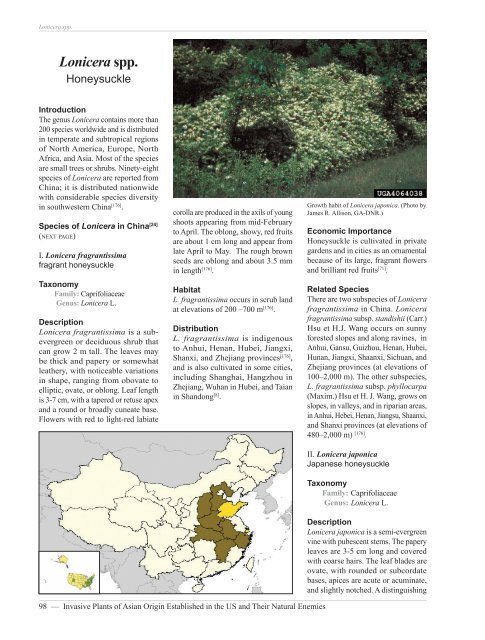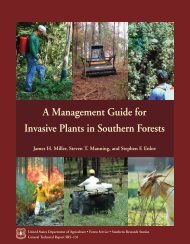Lonicera spp.
Lonicera spp.
Lonicera spp.
- No tags were found...
Create successful ePaper yourself
Turn your PDF publications into a flip-book with our unique Google optimized e-Paper software.
<strong>Lonicera</strong> <strong>spp</strong>.<strong>Lonicera</strong> <strong>spp</strong>.HoneysuckleIntroductionThe genus <strong>Lonicera</strong> contains more than200 species worldwide and is distributedin temperate and subtropical regionsof North America, Europe, NorthAfrica, and Asia. Most of the speciesare small trees or shrubs. Ninety-eightspecies of <strong>Lonicera</strong> are reported fromChina; it is distributed nationwidewith considerable species diversityin southwestern China [176] .Species of <strong>Lonicera</strong> in China [24](NEXT PAGE)I. <strong>Lonicera</strong> fragrantissimafragrant honeysuckleTaxonomyFamily: CaprifoliaceaeGenus: <strong>Lonicera</strong> L.Description<strong>Lonicera</strong> fragrantissima is a subevergreenor deciduous shrub thatcan grow 2 m tall. The leaves maybe thick and papery or somewhatleathery, with noticeable variationsin shape, ranging from obovate toelliptic, ovate, or oblong. Leaf lengthis 3-7 cm, with a tapered or retuse apexand a round or broadly cuneate base.Flowers with red to light-red labiatecorolla are produced in the axils of youngshoots appearing from mid-Februaryto April. The oblong, showy, red fruitsare about 1 cm long and appear fromlate April to May. The rough brownseeds are oblong and about 3.5 mmin length [176] .HabitatL. fragrantissima occurs in scrub landat elevations of 200 –700 m [176] .DistributionL. fragrantissima is indigenousto Anhui, Henan, Hubei, Jiangxi,Shanxi, and Zhejiang provinces [176] ,and is also cultivated in some cities,including Shanghai, Hangzhou inZhejiang, Wuhan in Hubei, and Taianin Shandong [8] .Growth habit of <strong>Lonicera</strong> japonica. (Photo byJames R. Allison, GA-DNR.)Economic ImportanceHoneysuckle is cultivated in privategardens and in cities as an ornamentalbecause of its large, fragrant flowersand brilliant red fruits [71] .Related SpeciesThere are two subspecies of <strong>Lonicera</strong>fragrantissima in China. <strong>Lonicera</strong>fragrantissima subsp. standishii (Carr.)Hsu et H.J. Wang occurs on sunnyforested slopes and along ravines, inAnhui, Gansu, Guizhou, Henan, Hubei,Hunan, Jiangxi, Shaanxi, Sichuan, andZhejiang provinces (at elevations of100–2,000 m). The other subspecies,L. fragrantissima subsp. phyllocarpa(Maxim.) Hsu et H. J. Wang, grows onslopes, in valleys, and in riparian areas,in Anhui, Hebei, Henan, Jiangsu, Shaanxi,and Shanxi provinces (at elevations of480–2,000 m) [176] .II. <strong>Lonicera</strong> japonicaJapanese honeysuckleTaxonomyFamily: CaprifoliaceaeGenus: <strong>Lonicera</strong> L.Description<strong>Lonicera</strong> japonica is a semi-evergreenvine with pubescent stems. The paperyleaves are 3-5 cm long and coveredwith coarse hairs. The leaf blades areovate, with rounded or subcordatebases, apices are acute or acuminate,and slightly notched. A distinguishing98 — Invasive Plants of Asian Origin Established in the US and Their Natural Enemies
<strong>Lonicera</strong> <strong>spp</strong>.Leaves and flowers of <strong>Lonicera</strong> japonica.(Photo by Jil M. Swearingen, USDI-NPS.)feature separating L. japonica fromrelated species is the upper leaf surface,which is greener than the underside.Growing in the leaf axils, the pubescentflowers, appearing from April to June,have conspicuous leaf-like bracts andwhite corollas, and appearing fromApril to June. The peduncle and leafpetiole are similar in size. The shiny,dark blue fruits are round, 6-7 mm indiameter, and mature from October toNovember [176] .Habitat<strong>Lonicera</strong> japonica occurs amongshrubs, along slopes, roadsides, insparse forests, hedges, and on gravelbanks at elevations up to 1500 m [176] .DistributionL. japonica is distributed nationwide inChina: however, it is not native to Hainan,Heilongjiang, Inner Mongolia, Ningxia,Qinghai, Xinjiang, or Tibet [176] .Economic ImportanceExtracts of chlorogenic acid andisochlorogenic acid are used medicinallyin China [176] .Related Species<strong>Lonicera</strong> japonica var. chinensis (Wats.)Bak. occurs in Anhui at elevations of upto 800 m. It is also cultivated in Jiangsu,Jiangxi, Yunnan, and Zhejiang [176] .III. <strong>Lonicera</strong> maackiiAmur honeysuckleTaxonomyFamily: CaprifoliaceaeGenus: <strong>Lonicera</strong> L.Description<strong>Lonicera</strong> maackii (Rupr.) Maxim isa deciduous shrub that can reach aheight of 6 m and a stem diameterof 10 cm. The entire plant is coveredwith glandular hairs. Winter buds aresmall, ovoid, and covered with morethan five pairs of scales. Papery leavesare ovate-elliptic to ovate-lanceolate, 5-8cm long with acuminate to narrowlyacuminate apices and a rounded orwedge-shaped leaf bases. The petioleis 2-5 mm cm long and is longer thanthe 1-2 mm long peduncle. Whiteto yellow, fragrant, axillary flowerswith labiate corollas and a linear tolanceolate bracts appear from Mayto June. Fruits are globular, dark-red,5-6 mm in diameter, and mature fromAugust to October [176] .HabitatL. maackii occurs in riparian areas at theedge of forests at elevations of 1,800m (3,000 m in some areas of Yunnanand Tibet) [176] .Fruits of <strong>Lonicera</strong> maackii. (Photo by ChuckBargeron, UGA.)Invasive Plants of Asian Origin Established in the US and Their Natural Enemies — 99
<strong>Lonicera</strong> <strong>spp</strong>.Natural Enemies of <strong>Lonicera</strong>Twenty-one fungi have been reportedto damage <strong>Lonicera</strong>. Six species arefound on L. japonica; four on <strong>Lonicera</strong>maackii, and one on fragrant honeysuckle.Microsphaera lonicerae can damageboth Japanese and fragrant honeysuckle.Puccinia festucae Plowright is found onboth Japanese and amur honeysuckle.Forty-four arthropod species have beenfound on <strong>Lonicera</strong> <strong>spp</strong>., of which 23species attack Japanese honeysuckleand four damage amur honeysuckle.Approximately 20 insect specieshave a narrow H. R. within the genus<strong>Lonicera</strong>.DistributionL. maackii is distributed throughoutAnhui, Gansu, Guizhou, Hebei,Heilongjiang, Henan, Hubei, Hunan,Jiangsu, Jiangxi [84] , Jilin, Liaoning,Ningxia [116] , Shaanxi, Shandong, Shanxi,Sichuan, Yunnan, and Zhejiang [176] , andrecorded as L. maackii podocarpaFranch. ex Rehd in Tibet.Economic ImportanceEssential oil of honeysuckle isextracted from the flower of Amurhoneysuckle. The stem is a source ofartificial cotton [176] .Related SpeciesOne variety of Amur honeysuckle, L.maackii var. erubescens Rhed., growson hillside slopes in Anhui, Gansu,Jiangsu, and Henan [176] .IV. <strong>Lonicera</strong> tataricaTartarian honeysuckleTaxonomyFamily: CaprifoliaceaeGenus: <strong>Lonicera</strong> L.Description<strong>Lonicera</strong> tatarica is a deciduous shrubthat grows 3 m in height. The wholeplant is nearly glabrous. The winterbuds have approximately four pairsof scales. Leaves are papery, ovate,oblong or ovate-oblong, 2-5 cm inlength, with a tapering apices androunded to subcordate bases. Leafmargins are covered with coarse hairs.Flowers are produced from May to June.Bracts are linear lanceolate or linearoblanceolate, equal to or longer thanthe length of the calyx tube. Corollasare pink or white, 1.5 cm long, andlabiate. Fruits are red, globular, 5-6mm in diameter and mature from Julyto August [176] .HabitatL. tatarica occurs on rocky slopes,forest edges, and scrubland in ravinesat elevations of 900–1,600 m.Distribution<strong>Lonicera</strong> tatarica is native to northernXinjiang. It is cultivated in Hebei [18] ,Heilongjiang, Liaoning [176] , andShanxi .Colorful flowers of <strong>Lonicera</strong> tatarica. (Photoby Patrick Breen, Oregon State University.)Related SpeciesL. tatarica L. var. micrantha Trautv.occurs in Xinjiang, on riverbanks at700-800 m elevation [176] .100 — Invasive Plants of Asian Origin Established in the US and Their Natural Enemies
<strong>Lonicera</strong> <strong>spp</strong>.Species of <strong>Lonicera</strong> in China [24]Scientific Name Scientific Name Scientific NameL. acuminata Wall. L. nervosa Maxim. L. altmannii Regel et Schmalh.L. nigra L. L. angustilfolia Wall. ex DC. L. nubium (Hand.-Mazz.) Hand.-Mazz.L. anisocalyx Rehd. L. oreodoxa H. Smith ex Rehd. L. bourtnei Hemsl.L. pampaninii Lévl. L. brevisepala Hsu et H. J. Wang L. pileata Oliv.L. buchananii Lace L. praeflorens Batal. L. buddleioides Hsu et S. C. ChengL. prostrata Rehd. L. caerulea L. L. retusa Franch.L. calcarata Hemsl. L. rhytidophylla Hand.-Mazz.L. calvescens (Chun et How) Hsu et H. J.WangL. rupicola Hook. f. et Thoms. L. carnosifolia C. Y. Wu ex Hsu et H. J. Wang L. ruprechtiana RegelL. chrysantha Turcz. L. semenovii Regel L. ciliosissima C. Y. Wu ex Hsu et H. J. WangL. sempervirens L. L. cinerea Pojark. L. setifera Franch.L. confusa (Sweet) DC. L. similis Hemsl. L. crassifolia Batal.L. stephanocarpa Franch. L. cyanocarpa Franch. L. subaequalis Rehd.L. dasystyla Rehd. L. subhispida Nakai L. elisae Franch.L. sublabiata Hsu et H. J. Wang L. fargesii Franch. L. tatarica L.L. ferdinandii Franch. L. tatarinowii Maxim. L. ferruginea Rehd.L. tragophylla Hemsl. L. fragilis Lévl. L. trichosantha Bur. et Franch.L. fragrantissima Lindl. et Paxt. L. trichosepala (Rehd.) Hsu L. fulvotomentösa Hsu et S.C. ChengL. tubliflora Rehd. L. graebneri Rehd. L. virgultorum W. W. SmithL. gynochlamydea Hemsl. L. yunnanensis Franch. L. hildebrandiana Coil. et Hemsl.L. alberti Regel L. hispida Pall. ex Roem. et Schult. L. codonantha Rehd.L. humilis Kar. et Kir. L. hemsleyana (O. Ktze.) Rehd. L. hypoglauca Miq.L. heterophylla Decne. L. hypoleuca Decne. L. jilongensis Hsu et H.J. WangL. inconspicua Batal. L. litangensis Batal. L. inodora W. W. SmithL. minuta Batal. L. japonica Thunb. L. minutifolia Kitam.L. kansuensis (Batal. ex Rehd.)Pojark.L. modesta Rehd. L. kawakamii (Hayata) Masam.L. oblata Hao ex Hsu et H.J. Wang L. lanceolata Wall. L. oiwakensis HayataL. ligustrina Wall. L. saccata Rehd. L. longilflora (Lindl.) DC.L. schneideriana Rehd. L. longituba H. T. Chang ex Hsu et H. J. Wang L. serreana Hand.-Mazz.L. maackii (Rupr.) Maxim. L. spinosa Jacq. ex Walp. L. macrantha (D. Don) Spreng.L. szechuanica Batal. L. macranthoides Hand.-Mazz. L. alpeiensis Hsu et H.J.WangL. maximowiczii (Rupr.) Regel L. tangutica Maxlm. L. microphylla Wllld. ex Roem. et Schult.L. tomentella Hook.f. et Thoms. L. mucronata Rehd. L. trichogyne Rehd.L. myrtilllus Hook. f. et Thoms. L. webbiana Wall. ex DC.Invasive Plants of Asian Origin Established in the US and Their Natural Enemies — 101
<strong>Lonicera</strong> <strong>spp</strong>.FungiPhylum Family Species H. R. Ref.AscomycotaBasidiomycotaErysiphaceaeMeliolaceaeMicrosphaera dipeltae Y.N. Yu & Y.Q. Lai oo 22Microsphaera erlangshanensis Y.N. Yu mo 22Microsphaera lonicerae (DC.) G. Winter o* ‡ 22Microsphaera vanbruntiana W.R. Gerard po 22Asteridiella lonicerae (W. Yamam.) Hosag.o* 62Phyllachoraceae Phyllachora xylostei (Fr.) Fuckel mo 23Rhytismataceae Rhytisma lonicericola Henn. o † 23Hymenochaetaceae Phellinus setulosus (Lloyd) Imazeki po 23Polyporaceae Fomes calcitratus (Berk. & M.A. Curtis) Cooke oo 23PucciniaceaePuccinia festucae Plowr.oo23 I* 22p* † 23Puccinia longirostris Kom. oo 23Anamorphic Ascomycetes Rhabdospora decipiens (Berk. & M.A. Curtis) Sacc. mo 23Anamorphic Discosphaerina Kabatia latemarensis Bubák oo 23Anamorphic Guignardia Phyllosticta caprifolii (Opiz) Sacc. mo 23Anamorphic Lophodermium Leptostroma lonicericola Rabenh. oo 23 IIAnamorphic MycosphaerellaCercospora lonicericola W. Yamam. m* 23Cercospora periclymeni G. Winter o* 23Septoria lonicerae-maackii Miura m † 23Anamorphic Mycosphaerellaceae Ascochyta tenerrima Sacc. & Roum. m* 23Anamorphic Rhytisma Melasmia lonicerae Jacz. o † 23* attacks <strong>Lonicera</strong> japonica† attacks <strong>Lonicera</strong> maackii‡ attacks <strong>Lonicera</strong> tartaricaIRecorded as Irenina lonicerae YamamIIRecorded as Leptostroma lonicericolum Rabenh.ArthropodsOrder Family Species H. R. Ref.Acariformes Rhyncaphytoptidae Rhyncaphytoptus lonicerae Kuang et Zhuo m† 83ColeopteraHemipteraAsias halodendri (Pallas) p* 65Cerambycidaem* 85Xylotrechus grayii (White)p* 140Liroetis loniceris Jiang oo 140Pseudoliroetis fulvipennis (Jacoby) p* 85Chrysomelidaeoo 140Trachyaphthona obscura (Jacoby)oo 158oo 185Zangia signata Jiang po 140Acanthosomatidae Platacantha forfex (Dallas) po 193Pentatomidae Piezodorus lituratus (Fabricius) p* 193102 — Invasive Plants of Asian Origin Established in the US and Their Natural Enemies
<strong>Lonicera</strong> <strong>spp</strong>.Amphicercidus sinilonicericola Zhangm* 85m* 189Microlophium carnosa (Buckton) po 140Neorhopalomyzus lonicericola (Takahashi) m* 158Neotoxoptera oliveri (Essig) m* 100p† 100AphididaeSemiaphis heraclei (Takahashi)p†* 158Homopterap†* 189o†* 65Trichosiphonaphis lonicerae (Uye)oo 85m† 100Tuberocephalus sp. m* 85Membracidae Telingana scutellata China po 140Pemphigidae Prociphilus ligustrifoliae (Tseng et Tao) mo 189Hymenoptera Argidae Arge similis (Vollenhoven) p* 65Hyphantria cunea (Drury) p† 41Arctiidaep* 40Pericallia matronula (Linnaeus)p* 41Angerona glandinaria Motschulsky po 138Ourapteryx sambucaria Linnaeus p* 138Geometridaem* 85Somatina indicataria Walkerp* 138Trichopteryx polycommata (Denis et Schiffermüller) p* 177Lymantriidae Porthesia similis (Fueszly)p* 65p* 198Conistra ligula (Esper) po 12NoctuidaeCrino satura (Schiffermüller) po 209Polia thalathina (Rottemberg) po 12Limenitis camilla (Linnaeus) p* 203Limenitis moltrechti Kardakoff p* 203Lepidoptera Nymphalidae Limenitis sulpitia (Cramer)p* 158po 203Parasarpa dudu (Westwood)p* 203po 203Saturniidae Antheraea yamamai Guerin-Meneville po 207p* 65SphingidaeHaemorrhagia staudingeri staudingeri (Leech)m* 206m* 206m* 208Adoxophyes orana Fischer von Röslerstammp* 65p* 113Archips xylosteana (Linnaeus) p* 113TortricidaeChoristoneura diversana (Hübner) p* 113Clepsis rurinana (Linnaeus) p* 65Clepsis semialbana (Guenée) p* 113Lozotaenia forsterana (Fabricius) p* 113Pandemis dumetana Treitshke po 141Thysanoptera Thripidae Frankliniella intonsa (Trybom) po 56* attacks <strong>Lonicera</strong> japonica† attacks <strong>Lonicera</strong> maackiiInvasive Plants of Asian Origin Established in the US and Their Natural Enemies — 103
















